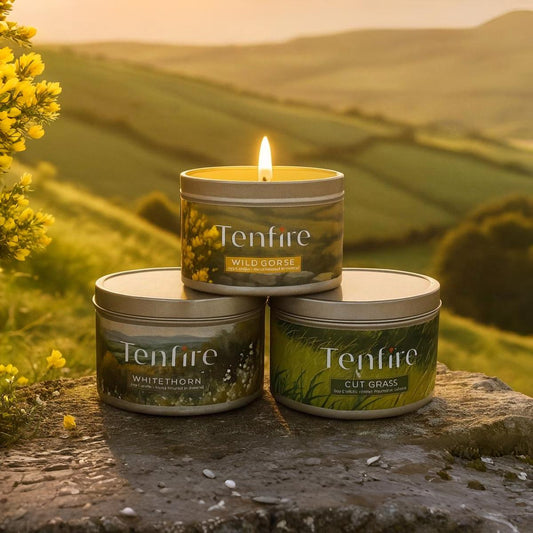
Candle Safety Myths: What You Think You Know vs What Actually Matters
By Dawn, Founder of Tenfire
Candles create comfort—but only when used safely. From the myth of burning candles overnight to misunderstandings about trimming wicks, there’s a lot of confusion out there. This guide clears up the most common candle safety myths and gives you practical tips to enjoy your Tenfire candles with peace of mind.
TL;DR
- Never leave a candle burning overnight or unattended.
- Trim wicks before each use to reduce soot, overheating, and uneven burning.
- Stop burning when about 1cm of wax remains in the jar for safety.
Why Candle Safety Still Matters
Candles have come a long way – especially those made with clean-burning waxes like soy, natural cotton wicks, and carefully formulated fragrance oils. But no matter how thoughtfully made a candle is, it’s still a live flame.
Every year, house fires start from unattended or improperly used candles. It’s rare – but preventable.
Tenfire candles are designed to be clean, slow-burning, and safe. But we always include safety guidance for a reason: knowing how to burn a candle properly helps it perform better and protects your space.
Let’s clear up some of the biggest misconceptions.

Myth #1: You Can Leave a Candle Burning Overnight
The truth: You should never leave a candle burning while you sleep or when you’re out of the room.
Even the most stable container candle carries risk. All it takes is a pet knocking something over, a draft blowing a curtain, or a candle that’s burned too low and overheats the glass.
Best practice:
- Extinguish candles before bed
- Never leave a room with an open flame unattended
- Set a timer or alarm if you like to burn candles for long periods
Founder’s note:
I always say: if you’re leaving the room, the candle goes out. Even in the studio, I follow that rule every time.
Myth #2: Candles Are Self-Extinguishing
The truth: No they’re not – and assuming they are is dangerous.
Some assume a candle will simply “burn out” when it hits a certain point or if the flame becomes unstable. But in reality, many candles will keep burning until:
- The wax pool gets too large and floods the wick
- The wick curls or mushrooms and produces a bigger flame
- The vessel overheats
All of these can be hazards if left unmanaged. Candles need human supervision – always.
How long exactly should you let a candle burn for? Read our blog exploring this.
Myth #3: You Don’t Need to Trim the Wick
The truth: Wick trimming is one of the easiest and most important ways to burn your candle safely.
When a wick is too long:
- The flame becomes unstable and tall
- It burns hotter, which can crack jars
- It produces excess soot
- The wax is consumed faster than intended
Trim to 5mm before each burn. You can use scissors or a proper wick trimmer. If you see a “mushroom” shape forming at the top of the wick, that’s your cue.
Tip: A trimmed wick also means a cleaner, more even burn – and a longer candle life.
Myth #4: Soot Means the Candle Is Bad Quality
The truth: Most soot comes from user error, not the candle itself.
Soot happens when:
- The wick is too long
- The flame is flickering due to drafts
- You’ve burned the candle too long (past the 3–4 hour mark)
All Tenfire candles are made with soy wax and cotton wicks, which are naturally cleaner-burning than paraffin and zinc wicks. But any candle can smoke if used improperly.
What to do:
- Trim your wick
- Move the candle out of a draft
- Extinguish after 3–4 hours and let it reset
Myth #5: It's Fine to Burn to the Bottom of the Jar
The truth: Always stop burning when about 1cm of wax remains at the bottom.
Why?
- The flame heats the jar base more directly, increasing risk of cracking
- Residual glue from wick stickers may ignite
- Metal wick holders (in mass-produced candles) can overheat
Tenfire candles are designed to burn cleanly down to their base, but we still recommend extinguishing when only a thin layer of wax remains. It’s safer – and makes a lovely excuse to start a new scent.
Here are some tips for lighting your candle for the first time.
Real-World Candle Safety Tips
These aren’t rules to scare you – they’re here to help you get the most from every candle.
Safe Burning Checklist:
- Place candles on a heat-resistant surface
- Keep away from children, pets, and curtains
- Burn for 1–4 hours at a time only
- Trim wick before each use
- Never move a candle while lit
- Ventilate your room after use
Wax Melt Safety:
- Use only in approved melt warmers
- Don’t add water or oils to the wax pool
- Never leave a burner unattended
- Let the burner cool fully before touching

Founder’s note:
At workshops, I often say: candle safety is candle care. It’s how you protect your space and make the most of your fragrance.
Final Thoughts
Candles are meant to bring comfort – not worry. When you follow a few simple rules, you can enjoy their warmth and scent with total peace of mind.
At Tenfire, we build safety into everything – from the shape of our wicks to the type of wax we use – but what matters most is how you burn them.
Light with intention, stay present, and make each flame part of a ritual that feels safe, grounding, and good.
— Dawn





